
They had a side of Albert park filled with a collection of beautiful specimen flowers and I decided to present them along with the names. It is quite a cosmopolitan collection, filled with little flower puzzles. I write these posts on the specifics of flowers, including names and a little history both for myself and for you, the reader. Flowers and plants are beautiful in their own right but knowing what kind of plant you are seeing allows you to find parallels and insights into your own gardening and gardens in general. Some of these individual flowers have attracted hundreds of thousands of interested people to join societies, discuss in garden clubs and even to host shows devoted to a particular flower. Examples include Roses, Canna Lillies, Crocosmia, Dahlias, Succulents and Chrysanthemums to name just a few. These garden groups are often not easy to find but show a light on the culture of people living in a particular locale. For instance, New Zealanders or Kiwis are crazy interested in succulents. I hope you too will find these garden posts useful and will enhance your enjoyment the next time you visit a garden or see an unusual plant.
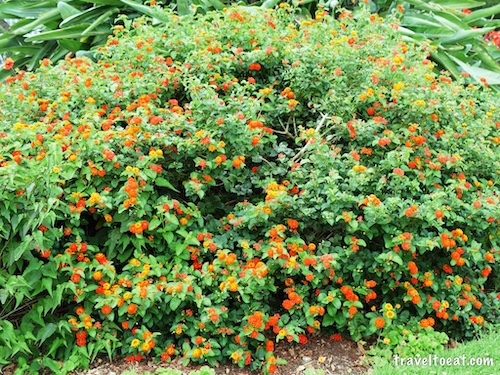
Lantana camara L. also known as Spanish Flag, West Indian Lantana (American tropics). Lantana camara, also known as big sage (Malaysia), wild sage, red sage, white sage (Caribbean) and tickberry (South Africa), is a species of flowering plant within the verbena family, Verbenaceae, that is native to the American tropics. The name Lantana derives from the Latin name of the wayfaring tree Viburnum lantana, the flowers of which closely resemble Lantana. Lantana became a favorite greenhouse plant in the 18th century. This plant was such a desired species that many new varieties were bred, resulting in hundreds of cultivars available for sale in the European market. The newer cultivars were introduced to several countries on a regular basis, assisting in the worldwide distribution of Lantana. Lantana flowers attract butterflies and hummingbirds with bright colors and abundant nectar. Here in Las Vegas this is a popular plant and I have some growing in my front yard. Here we just call this variety Orange/Red Lantana.

Internationally, canna lilies are one of the most popular garden plants and a large horticultural industry depends on the plant. Canna is the only genus in the family Cannaceae. Although a plant of the American tropics, most cultivars have been developed in temperate climates and are easy to grow in most countries of the world. The foliage of Canna Lily Tropicana Black (Canna indica lon01) is a combination of purple shades blended with black. This is topped by the flowers, from Spring through to Fall, with blooms in rich scarlet-orange.

Canna “Yellow King Humbert” (Canna x generalis ‘Yellow King Humbert’) is a medium sized Heirloom Canna from Italy with flower clusters that are open and yellow with sharply defined red spots, often large red markings and occasionally whole red flowers. Staminodes are large, the seeds are sterile and the pollen is sterile. This is the oldest known Canna chimera, the earliest research reference is Sonderegger Nursery Catalogue, USA, 1929. There is an early reference to Luther Burbank being the originator. A chimera is a plant in which one species is grafted onto a different species resulting in the cells of both plants being present. Propagation is by cloning only. In practice graft-chimaeras are not noted for their stability and may easily revert to one of the “parents”. This Canna Lily is often confused with Heirloom Canna Florence Vaughan (also called Canna Roma) (Canna indica).


Crocosmia is a small genus of flowering plants in the iris family, Iridaceae. It is native to the grasslands of southern and eastern Africa, ranging from South Africa to Sudan. One species is endemic to Madagascar. Crocosmias are grown worldwide, and more than 400 cultivars have been produced. This is an extremely variable hybrid and gardeners have selected many beautiful cultivars and hybridized some of them back to other wild species. Most are known by their cultivar names without the botanist’s “X crocosmiiflora”. Crocosmia ‘Citronella’ (a.k.a. ‘Golden Fleece’) has gorgeous lemon yellow flowers. ‘Emily McKenzie’ is a real beauty with nodding flowers that are vibrant orange with crimson throats. ‘Jackanapes’ has smaller, bicolored orange and yellow flowers. Since we saw these before they flowered, I really do not know the varietal name.

A daylily is a flowering plant in the genus Hemerocallis. Gardening enthusiasts and professional horticulturalists have long bred daylily species for their attractive flowers. Thousands of cultivars have been registered by local and international Hemerocallis societies. This variety is called “Fooled Me”.



Passiflora vitifolia is a species of Passiflora, native to southern Central America (Costa Rica, Nicaragua, Panama) and northwestern South America (Venezuela, Colombia, Ecuador, Peru). It is a vine with cylindric stems covered in red-brown hairs when young. The leaves are serrated and three-lobed, up to 15 cm (5.5 in) long and 18 cm (7 in) broad. The lobed leaves’ resemblance to grape leaves gives this passionflower its specific epithet, “vitifolia,” meaning “grape leaves” after the Latin for grape “vitis.” The flowers are bright red, up to 9 cm (3.5 in) in diameter. The fruit is a berry 5 cm (2 in) long and 3 cm (1.25 in) broad, with green flesh speckled with white, slight downy hairs, containing numerous seeds. Passiflora, known also as the passion flowers or passion vines, is a genus of about 500 species of flowering plants, the namesakes of the family Passifloraceae. They are mostly vines, with some being shrubs, and a few species being herbaceous. During the Victorian era the flower (which in all but a few species lasts only one day) was very popular, and many hybrids were created using the winged-stem passion flower (P. alata), the blue passion flower (P. caerulea) and other tropical species.
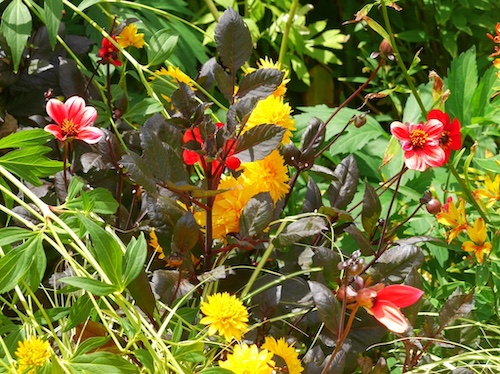
Dahlia is a genus of bushy, tuberous, herbaceous perennial plants native to Mexico. A member of the Asteraceae (or Compositae), dicotyledonous plants, related species include the sunflower, daisy, chrysanthemum, and zinnia. There are 42 species of dahlia, with hybrids commonly grown as garden plants. The first plants arrived in Madrid in 1798 but they were soon lost as they were grown in conditions which were far too warm. In the early years of the nineteenth century, plants were introduced again and as its cultivation became better understood. The first three introduced were Dahlia coccinea, a single red, D. rosea, a single pink and D. pinnata a semi-double purple.


Chrysanthemums, sometimes called mums or chrysanths, are flowering plants of the genus Chrysanthemum in the family Asteraceae. They are native to Asia and northeastern Europe. Most species originate from East Asia and the center of diversity is in China. Chrysanthemums were first cultivated in China as a flowering herb as far back as the 15th century BC. Over 500 cultivars had been recorded by the year 1630. The plant is renowned as one of the Four Gentlemen in Chinese and East Asian art. The plant is particularly significant during the Double Ninth Festival. The flower may have been brought to Japan in the eighth century AD and the Emperor adopted the flower as his official seal. The “Festival of Happiness” in Japan celebrates the flower. Mums are so popular that there are societies and shows just for them. A simple classification divides them into hardy Garden Mums and showy exhibition Chrysanthemums.

Sabin’s Lupine (Lupinus sabinianus) is a species known only from a small area on the west slopes of the central Blue Mountains of eastern Oregon. It is an unusually large and showy lupine with bright yellow flowers and handsome dark green foliage. Sabin’s lupine is a perennial species that can grow to more than 3 feet tall in bloom, with clumps that are 2 to 3 feet across. Flowering stems carry a tall spike of yellow flowers that stand well above the dark leaves. Because it is in the pea family, each blossom that gets fertilized produces a small, fuzzy pod with several pinkish-brown bean-like seeds inside. The leaves are “palmate”, with an uneven number of narrow leaflets radiating from a central “palm” to form a shape like a flattened umbrella.

Cudweed (Anaphalioides trinervis – Asteraceae) is a New Zealand native plant called Puatea in Maori. Anaphalioides is a genus of flowering plants in the daisy family described as a genus in 1950. They are native to New Zealand, Australia, and New Guinea.

Daucus carota, whose common names include wild carrot, bird’s nest, bishop’s lace, and Queen Anne’s Lace (North America), is a flowering plant in the family Apiaceae, native to temperate regions of Europe, southwest Asia and naturalized to North America and Australia.

Silene coronaria is a species of flowering plant in the carnation family Caryophyllaceae, native to Asia and Europe. Common names include rose campion, dusty miller (this also refers to Centaurea cineraria and Jacobaea maritima), mullein-pink and bloody William. In the United Kingdom it is still widely referenced under its synonym Lychnis coronaria.


Hylotelephium spectabile (formerly called Sedum spectabile) is a species of flowering plant in the stonecrop family Crassulaceae, native to China and Korea. Its common names include showy stonecrop, ice plant, and butterfly stonecrop. Growing to 45 cm (18 in) tall and broad, it is an herbaceous perennial with alternate, simple, toothed leaves on erect, unbranched succulent stems. The star-shaped pink flowers are borne in flat cymes (groups) 15 cm (6 in) across, in fall. The specific epithet/name “spectabile” means “showy”. This plant is valued in cultivation as drought-tolerant groundcover and numerous cultivars have been produced. As an aside, the leaves of most stonecrops are edible, excepting Sedum rubrotinctum, although toxicity has also been reported in some other species.

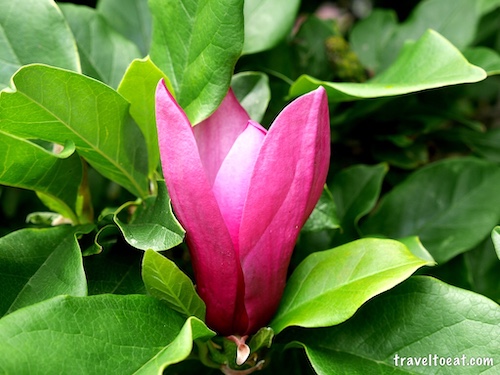
Magnolia liliiflora (variously known by many names, including Mulan magnolia, Purple magnolia, Red magnolia, Lily magnolia, Tulip magnolia, Jane magnolia and Woody-orchid) is a small tree native to southwest China (in Sichuan and Yunnan), but cultivated for centuries elsewhere in China and also Japan.


Lythrum salicaria (purple loosestrife) is a flowering plant belonging to the family Lythraceae. It should not be confused with other plants sharing the name loosestrife that are members of the family Primulaceae. Other names include spiked loosestrife, or purple lythrum.The purple loosestrife has been introduced into temperate New Zealand and North America where it is now widely naturalised and officially listed in some controlling agents. It is considered an invasive species or weed in some localities.


The garden heliotrope (Heliotropium arborescens) is a highly fragrant perennial plant, originally from Peru. It is especially notable for its intense, rather vanilla-like fragrance. Common names include cherry pie and common heliotrope. During the Victorian era in England this plant gained great recognition, often appearing in gardens and the borders of parks. Usually the leaves are dark green but one cultivar, “Aurea”, is grown for its golden leaves. They will appear lime-colored in part-shaded sites and have scented mauve flowers, but the primary attraction is the broad, soft, yellow foliage. Like most gold or lime leaves, it is a brilliant partner to blue or purple flowers. This variety has fragrant, vanilla-scented violet flowers in sprays bloom atop the tall stems. The yellow leaves are tinged with purple.

Ceratostigma willmottianum is a species of flowering plant in the family Plumbaginaceae that is native to western China and Tibet. It is an ornamental deciduous shrub that grows to 1 m (39.37 inches) in height, with pale blue plumbago-like flowers appearing in autumn as the leaves start to turn red.
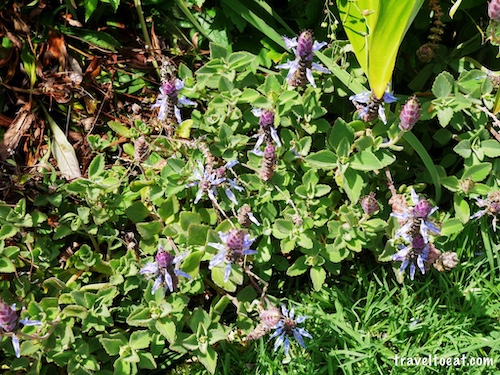




Plectranthus Lois Woodhull (Plectranthus neochilus) is a large plant with light green foliage and a strong medicinal, camphor scent. Discovered in South Africa by June Croon, and named in honor of her sister, noted plantswoman Lois Woodhull of Long Island, NY. Velvety green leaves surround blue, salvia-like flower spikes. It blooms nonstop from spring through late fall. This is a complicated plant to identify due to the reorganization of the classification of coleus. Coleus was a genus of flowering plants in the family Lamiaceae. In recent classifications, the genus is no longer recognized, and the formerly included species are instead placed in the genera Plectranthus and Solenostemon. Because the type species, Coleus amboinicus (Plectranthus amboinicus) is now placed in Plectranthus, Coleus is regarded as a synonym of Plectranthus. Prunella is also a genus of herbaceous plants in the family Lamiaceae, also known as self-heals, heal-all, or allheal for their use in herbal medicine. The flower above looks a lot like Prunella vulgaris but the leaves of the plants are different and most importantly the stamens of the flowers are different.

Blue Eyed Grass (Sisyrinchium angustifolium) grows in a clump around 1-2 ft (30-60 cm) across and about the same height. The leaves are linear, up to 20 in (50 cm) long, often grow in the shape of a fan, and look a lot like grass leaves. They are evergreen in mild climates. The flowers have six bluish purple “petals” with yellow centers. (Actually the “petals” consist of three sepals and three true petals, but they all look pretty much alike.) The flowers are about three-quarters of an inch (1.9 cm) across, and stand erect above the leaves on slender grasslike flattened stalks. Individually, they are short lived, but the succession of flowers can last several weeks in spring and early summer. When we visited in the middle of the summer, the blooms were almost gone but I found this straggler to photograph.

Centaurea cyanus, commonly known as cornflower, bachelor’s button, bluebottle, boutonniere flower, hurtsickle or cyani flower, is an annual flowering plant in the family Asteraceae, native to Europe. “Cornflower” is also used for chicory, and a few other Centaurea species; to distinguish C. cyanus from these it is sometimes called common cornflower.

Purple Cranesbill (Geranium x magnificum) is a species of hardy flowering herbaceous perennial plant in the genus Geranium, Geraniaceae family. It is the result of hybridisation between Geranium platypetalum and Geranium ibericum. It has lobed leaves with violet-blue flowers in summer. The blossoms attract butterflies and are about twice the size of most hardy geranium flowers, two inches rather than the average one inch across. Burman . Geranium incanum is included in the genus hardy geraniums, and family geraniaceae. No subspecies are listed in the Catalogue of Life. The genus Geranium contains more than 420 plant species, which are also known as cranesbill or hardy geranium (to distinguish them from Pelargonium species). Cranesbill. It isn’t Meadow Cranesbill (Geranium pratense) because the petals are notched. Compare with 517948 However I can’t decide whether it’s Wood Cranesbill (G sylvaticum) or Purple Cranesbill (G x magnificum).


Campanula glomerata, known by the common names clustered bellflower or Dane’s blood, is a species of flowering plant in the genus Campanula, belonging to the family Campanulaceae. It is the county flower of Rutland, England. The name of this plant is quite intuitive: the genus Latin name (“campanula”), meaning small bell, refers to the bell-shape of the flower, while the specific name (“glomerata”) refers to the tight grouping of the flowers at the top of the stem. The species is native to the North Temperate Zone of Eurasia, from Europe to Japan. In Europe it is present almost everywhere except the extreme north. In North America the plant is naturalized.


Thunbergia battiscombei, also known as blue glory vine, blue clock vine, blue boy, is an evergreen vining shrub in warm frost free areas (or in a greenhouse) or a herbaceous perennial in areas that do get frost. In the shrub form it has a flowing fountain form that can reach to 4-6 feet tall and 6-8 feet wide. It comes from tropical Eastern Africa.


Salvia guaranitica (Anise-scented sage, Hummingbird sage) is a species of Salvia native to a wide area of South America, including Brazil, Paraguay, Uruguay, and Argentina. The leaves are ovate, 4 cm (1.6 in) long and nearly as wide, with a fresh mint green color, and an anise scent when crushed. The inflorescences are up to 25 cm (9.8 in) long with flowers in various shades of blue, including an uncommonly true blue.


With their thick, glossy leaves and spectacular blue flowers, Chatham Island forget-me-nots (Myosotidium hortensia) are one of the most attractive of New Zealand’s herbaceous plants. It is not a true forget-me-not (Myosotis species), but was given the name because its flowers are very similar. There is only one species of Myosotidium, and in the wild it grows on exposed coastal sites in the Chatham Islands. I included a picture of the flowers from Wikipedia since they were not in bloom when we were visiting.
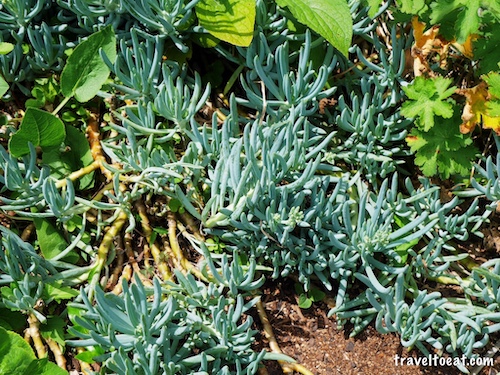
Senecio serpens or Blue Chalksticks is a species of the genus Senecio and dwarf shrub from the family Asteraceae that is indigenous to southern Africa. It needs little water, and is thus one of the many plants suggested for cultivation in Australia.

Spider Aloe (Aloe spinosissima) is a hybrid of Aloe arborescens and Aloe humilis. Spider aloe produces densely clumped rosettes 31-39″ (80-100 cm) in size. Each rosette, 40 cm wide for a mature plant has succulent leaves long, firm and flattened that taper in curving. The leaves have a greenish-blue skin. The margins have many small white teeth, a little pungent, the upper surface is almost smooth, while the lower surface is marked with small white points. When it blooms in spring, the flowers appear on stalks 16-18″ (40-45 cm) tall, and are bright coral-red.
I am going to stop here. As always, I hope you enjoyed the flowers and please leave a comment.
[mappress mapid=”116″]
References:
Albert Park: http://www.aucklandcouncil.govt.nz/EN/parksfacilities/premierparks/Pages/albertpark.aspx
Lantana: http://plants.ifas.ufl.edu/node/223
Crocosmia: http://www.pacificbulbsociety.org/pbswiki/index.php/Crocosmia
Ceratostigma: http://www.telegraph.co.uk/gardening/3324366/How-to-grow-Ceratostigma.html
Chrysanthamum Society: http://www.mums.org/
Sabine’s Lupine: http://www.fs.fed.us/wildflowers/plant-of-the-week/lupinus_sabinianus.shtml
Heliotropium arborescens Aurea: http://www.igarden.com.au/plant-type.jsp?t=Heliotropium&q=Plant
Heliotropium arborescens: http://plantlust.com/plants/heliotropium-arborescens/
Fooled Me Daylily: http://www.kinseyfamilyfarm.com/nursery-plants/daylily.html
Passiflora vitifolia: https://en.m.wikipedia.org/wiki/Passiflora_vitifolia
Thunbergia battiscombei: http://www.dallasplanttrials.org/index.cfm/fuseaction/articles.detail/articleID/93/index.htm
Thunbergia varities: https://toptropicals.com/catalog/uid/Thunbergia_battiscombei.htm
Prunella: http://toptropicals.com/cgi-bin/garden_catalog/cat.cgi?find=Coleus&sale=1&forsaleonly=1&namesonly=1
Prunella Vulgaris: https://gobotany.newenglandwild.org/species/prunella/vulgaris/
Blue Eyed Grass: http://mobile.floridata.com/Plants/Iridaceae/Sisyrinchium%20angustifolium/1078

